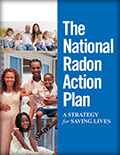Many Americans take great care to protect their health by doing things like eating right, exercising and avoiding known cancer-causing substances like tobacco and air pollution. But one precaution that many health conscious individuals may not even think of when it comes to safeguarding their health is protecting themselves and their families from an invisible gas that often lurks within their own homes: radon.
Radon is a colorless, tasteless, odorless gas that exists naturally. It forms when uranium breaks down to radium, which in turn breaks down to form radon. As radon decays, it releases radioactive byproducts that are inhaled and can cause lung cancer. In fact, radon is the second leading cause of lung cancer. Lung cancer deaths in the U.S. from radon exposure are estimated at 21,000 per year.
Many of us may not even hear of radon until the purchase of our first homes. That's because radon only becomes a health problem when it gets trapped indoors and concentrations build up to dangerous levels.
If you live in a home that to your knowledge has not been tested for radon, January is a perfect time to take action and test. January is Radon Action Month and the EPA says that winter is an especially good time to test because windows and doors are closed and families tend to spend more time inside where radon can be trapped.
It is suggested you take steps to remediate your home if your radon level registers at 4 picocuries per liter (pCi/L) or higher. The U.S. Environmental Protection Agency (EPA) estimates that nearly one out of every fifteen homes in the United States has unsafe indoor radon levels.
The American Lung Association is the leading organization working to save lives by improving lung health and preventing lung disease. Protecting the public from the harms associated with unhealthy levels of radon is an important part of our mission. That's why we're encouraging the public to take a moment to learn about radon this January and test your homes, if you live in a high-risk area.
Inexpensive radon kits can be purchased at many hardware stores. The Lung Association also sells radon kits for only $14.50. They are available by calling 1-800-LUNG-USA.
If after testing you do find that you have a radon problem the good news is that it is fixable. From sealing cracks in floors and walls to changing the flow of air into your house, you can protect your family. Repairs to decrease radon levels should be made by a U.S. EPA- or state-certified contractor.
 To learn more about radon and the strategies the Lung Association is recommending we adopt to reduce exposure, read the National Radon Action Plan: A Strategy for Saving Lives, that the American Lung Association developed with the U.S. Environmental Protection Agency, the U.S. Department of Housing and Urban Development, the U.S. Department of Health and Human Services and eight other national partners. For more information about radon, view the Connecticut Department of Public Health's video about radon testing or visit our website at Lung.org/radon.
To learn more about radon and the strategies the Lung Association is recommending we adopt to reduce exposure, read the National Radon Action Plan: A Strategy for Saving Lives, that the American Lung Association developed with the U.S. Environmental Protection Agency, the U.S. Department of Housing and Urban Development, the U.S. Department of Health and Human Services and eight other national partners. For more information about radon, view the Connecticut Department of Public Health's video about radon testing or visit our website at Lung.org/radon.